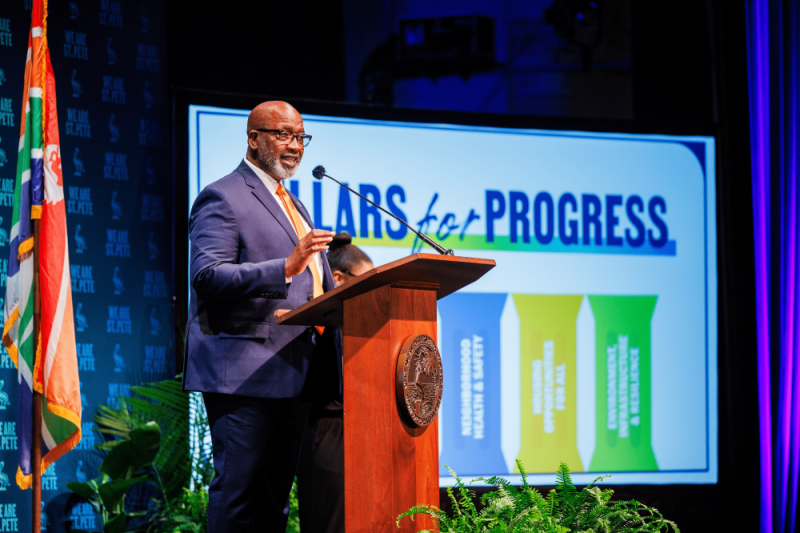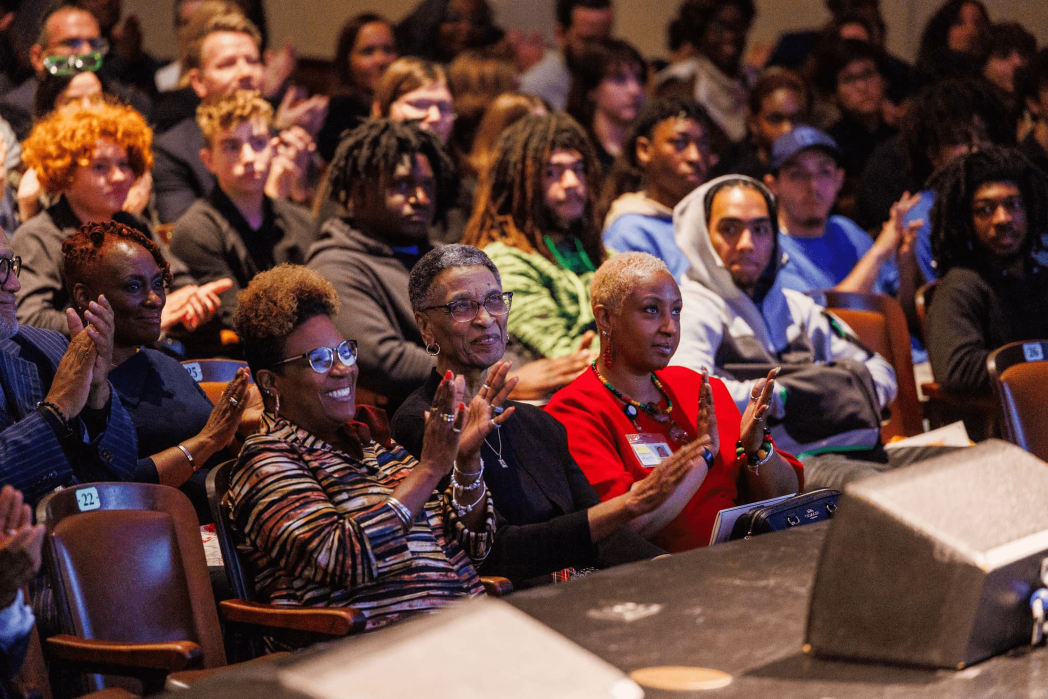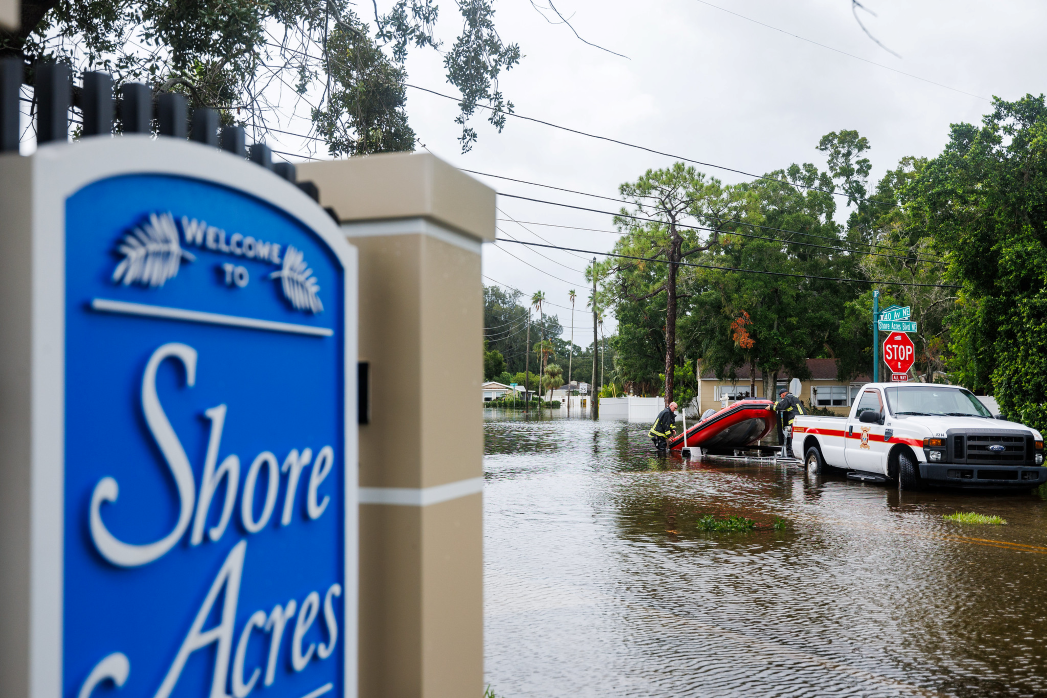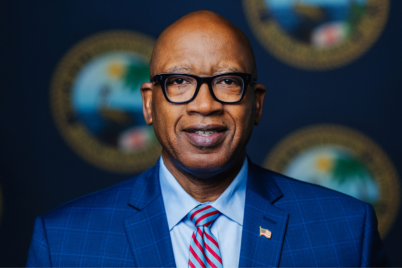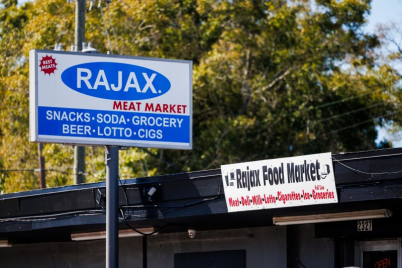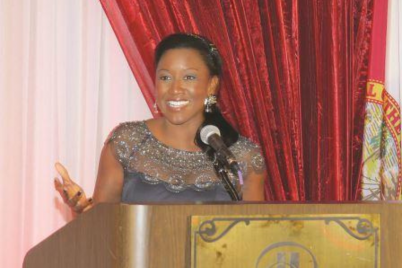Approximately 800 people attended the Palladium Theater on Tuesday, Jan. 30, as Mayor Ken Welch gave a 45-minute State of the City speech.
BY FRANK DROUZAS | Staff Writer
ST. PETERSBURG — In his 2024 State of the City address at the Palladium on Jan. 30, Mayor Ken Welch underscored the importance of resiliency, innovation, environmental protection and community engagement with his “Pillars of Progress.”
“We remain committed to inclusion for all, and we will strive to maintain our perfect score on the human rights index, which we achieved last year for the 10th year in a row,” he said. “Our new office of equity and the newly approved Minority and Women-Owned Business Enterprise Program were both created within that intentional framework.”
His administration respects the lived history and experience of the residents of our city, he went on, and that approach has guided its development of the historic Gas Plant in a manner that honors the history of that land. “We categorize our work into service areas or “pillars for progress,” Welch said, explaining that they are education and youth opportunities, equitable development, arts and business opportunities, healthy and safe neighborhoods, housing opportunities for all, environment infrastructure and resilience.
“In our city, our planning, our budgeting, our operations are all focused on those pillars and our commitment to equity is foundational throughout our work,” the mayor said.
Citing examples, he explained that the city is focused on impactful programs to connect our youth with opportunities to develop a well-prepared workforce. Towards that end, he announced a new initiative, the Mayor’s Future Ready Academy, an 18-week job training program providing full-time pay and employee benefits.
“Cadets also receive additional certification at Pinellas Technical College, and our hope is that many will choose to seek permanent employment with the city,” Welch said.
The city is expanding and refining its “Not My Child” and “Cohort of Champion” programs under the Office of Community Impact, as these programs are critical, focusing on educational and community support and anti-violence efforts. The mayor announced Dr. Sheron Brown as the city’s new director of Education and Youth Opportunities and noted that the city has added $1.1 million worth of new funding for literacy and youth employment programs in this fiscal year.
His administration also has plans to transform the Enoch Davis Center into an Opportunity and Innovation Center, “a modern hub for education, nutrition, digital access, wellness and other services vital to the wellbeing of the surrounding community and impacted groups, including our seniors and youth.”
The Parks and Recreation Department plays a vital role in supporting our youth as well, Welch underscored, providing comprehensive afterschool programs for both elementary and middle school students, including the TASCO afterschool technology programs, offering courses in digital videography, photography, graphic arts and more.
“We also understand that nutrition is a critical issue for many families,” he said, “the city’s provided 175,000 meals in our summer food program, and additional meals and snacks are provided through our Parks and Recreation Department.”
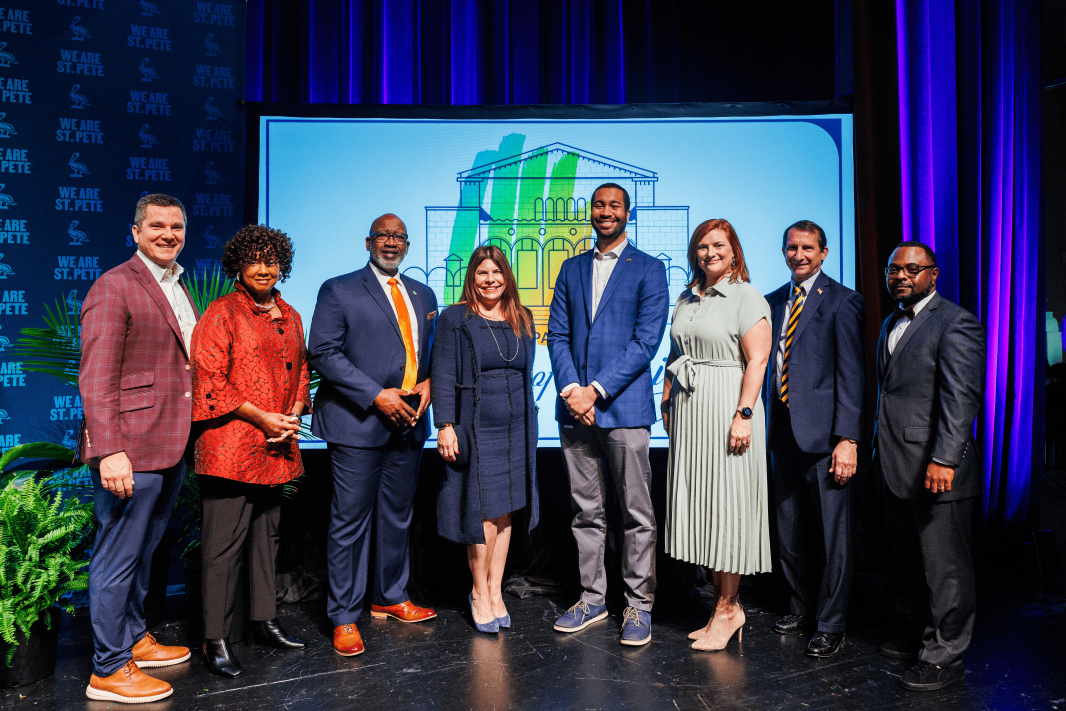
Charles Copley Gerdes, Deborah Figgs-Sanders, Mayor Ken Welch, Lisset Hanewicz, Richie Floyd, Brandi Gabbard, Ed Montanari and John Muhammad
Concerning equitable development, arts and business opportunities, St. Petersburg is dedicated to driving inclusive economic development that enhances the quality of life for all residents and avoids community displacement, Welch said. Key initiatives in 2023 included the South St. Pete (CRA) Microfund Program, which offers capacity building, education, mentoring and networking, along with funding for business improvements. In 2023, $440,000 was allocated, with 53 business owners completing the program’s first cohort. He said the city received more than 130 applications for consideration for the second, third, and fourth cohorts.
With the city council’s approval, the administration has adopted a Minority and Women Business Enterprise Program, which addresses the documented underutilization of minority- and women-owned businesses by removing barriers and actively working to expand the business opportunities for this business.
“After opening the portal for applications on Jan. 1 of this year,” Welch said, “we have 25 applications under review and four certified MBAs. I’m proud of the work of our Office of Supplier Diversity, and we look forward to the success of this office in building access to the city’s economic engine to traditionally underutilized businesses.”
Last year, the Arts and Culture Grant Program provided operating funds to 30 organizations, and in collaboration with the city’s poet laureate, Gloria Munoz, the City of Writers Poetry Festival celebrated the writing community with 30 events across St. Pete, emphasizing both emerging and established writers.
Also, last month marks the opening of the ARK Innovation Center in St. Pete’s burgeoning Innovation District. Developed in partnership with the Federal Economic Development Administration, Pinellas County, ARK Invest and the Tampa Bay Innovation Center, this center will be an economic driver, generating an estimated $28 million in economic impact in creating more than 1,200 direct and indirect jobs by 2026.
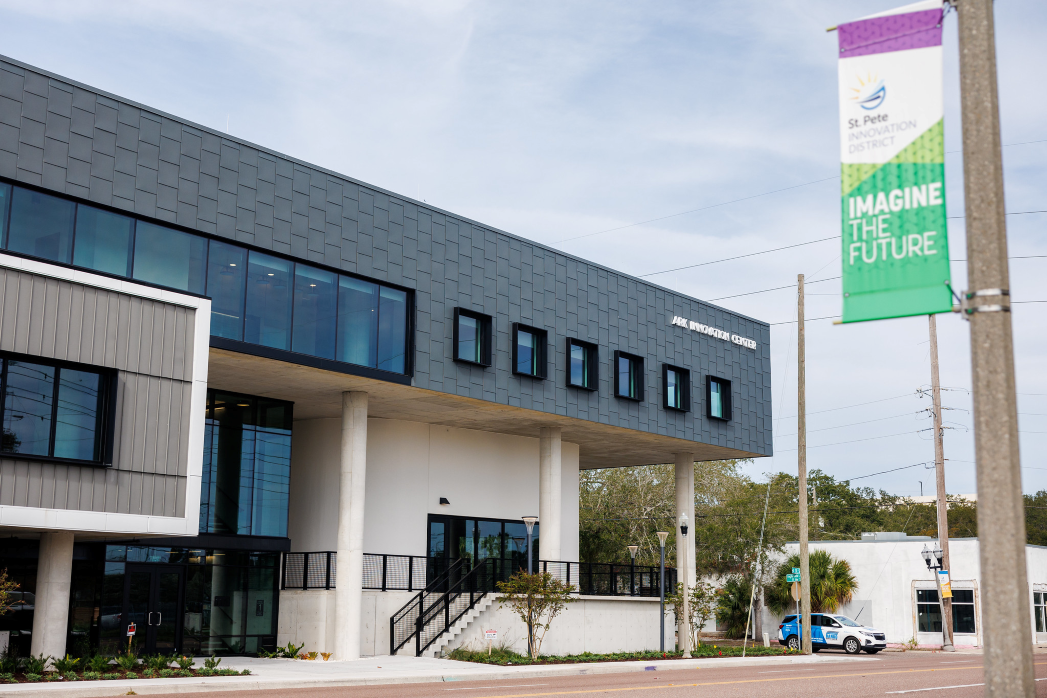
ARK Innovation Center, located at 1101 4th St. S in St. Petersburg, is a business incubator where start-up founders can connect with mentors.
Speaking of the safe and healthy neighborhoods pillar, Welch stressed that St. Pete is committed to creating safer and healthy communities throughout the city, from healthy food access to healthcare supportive services, recreation and crime reduction.
“Our goal is to support and maintain neighborhoods where all of our families are safe, healthy, and thriving,” he said. “Some of the highlights of this pillar include the Community Support Hubs Initiative led by The Well and supported by the American Rescue Plan funds — ARPA. These hubs will provide trauma-informed therapy, case management and outreach tailored to the community’s needs.”
Over 330 community members contributed input for the hub’s rollout with the goal of a network established across St. Pete, he noted, adding that the first hub is up and running already, with a grand opening scheduled for Mar. 1.
“We know that access to fresh food is limited in many of our neighborhoods,” Welch said. “The FRESH Pace Healthy Neighborhood Store Program, in partnership with the St. Pete Free Clinic and funded again by ARPA, expands access to healthy food in lower-income neighborhoods.”
Last year, the St. Petersburg Police Department continued its impactful and accountable approach to public safety, he said, adding that the Community Assistance and Life Liaison Program, or CALL, continued to exemplify a “smart and innovative approach to public safety.”
The program has successfully reached 10,000 contacts, illustrating its effective and community-centric approach to policing by directing certain nonviolent calls to social workers. The city council’s approval of a three-year agreement extension and increased funding for the program have extended operating hours and increased the program’s impact.
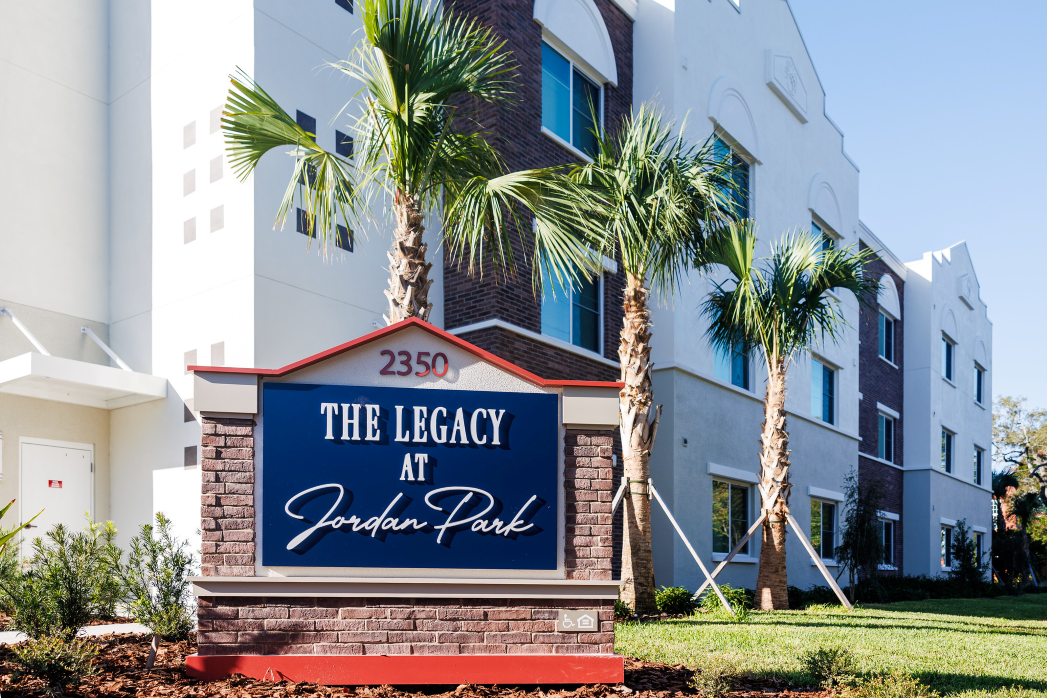
The city preserved or completed 155 units, including the Sixteenth Square Townhomes, Jordan Park residences and Citrus Grove Apartments.
The mayor explained that St. Pete is not immune to the increase in housing costs that cities across the nation are facing, so we must continue focusing on producing and preserving houses for those who make average salaries and less. He lauded the development of 282 multifamily affordable housing units, with 834 more units funded or approved, and said that the city preserved or completed 155 units, including the Sixteenth Square Townhomes, Jordan Park residences and Citrus Grove Apartments.
“Our initiatives also include 154 non-subsidized workforce density bonus units,” he said. “Through our Affordable Lot Disposition Program, we’ve sold 10 city-owned single-family lots to qualified families, paving the way for new affordable homes. We’ve also created 13 affordable single-family homes for those earning less than 120 percent of area median income through various programs.”
His administration’s development of policies and dedication to funding for environmental protection and infrastructure continued last year. Welch said that facing the challenges of rising sea levels and extreme weather, it has prioritized protecting the environment, modernizing infrastructure and increasing the community’s resiliency.
“Hurricane Idalia and the no-name December storm highlighted our increasing challenge with sea level rise and the increased flooding impacts on neighborhoods across our city, including Shore Acres, Riviera Bay, Coquina Key, the neighborhoods around Lake Maggiore and other parts of the city,” he said. “So, in response, we will continue to seek ways to enhance our investments in our stormwater infrastructure.”
The city has been making progress in the hardening of its infrastructure, which includes the completion of the new, safer, more accessible 40th Avenue Northeast Bridge and an increased effort to secure a $20 million grant award from the Florida Department of Environmental Protections Resilient Florida Program.
“Now, this funding allows us to enhance water infrastructure and address stormwater flooding around Lake Maggiore,” he said. “And speaking of Lake Maggiore, it is looking much better these days.”
The city has several longstanding projects that will achieve significant milestones this year, Welch pointed out, with the most prominent being the redevelopment of the historic Gas Plant district. Since announcing the selection of the Hines-Rays group as a development team last year, “our team has been working very hard and very effectively since then.”
“Now our team has met every project milestone, and today we’re working diligently with city council, with our partners, with the Hines-Rays Group in Pinellas County to finalize agreements that will bring this 40-year saga of the historic Gas Plant and the future of the raise to a positive conclusion,” the mayor said.
With $6.5 billion in investment, 37,000 projected jobs, significant and much-needed office and conference space, 1200 units of affordable and workforce housing, a $500 million commitment to minority participation and $50 million in additional community benefit and more, the return to the city and the county for this investment will be substantial, he said.
“The city’s costs are capped and utilize the same revenue streams that we’ve traditionally used for Tropicana Field and will use revenues generated by new development where 86 acres of asphalt sits now,” Welch said. “The cost is also shared with the Rays paying more than half of the stadium costs and Pinellas County paying slightly more than the city.”
Welch closed by praising the Hines-Rays group, noting that the city will never have a better opportunity to “turn the page and move to a new chapter at the historic Gas Plant.”

